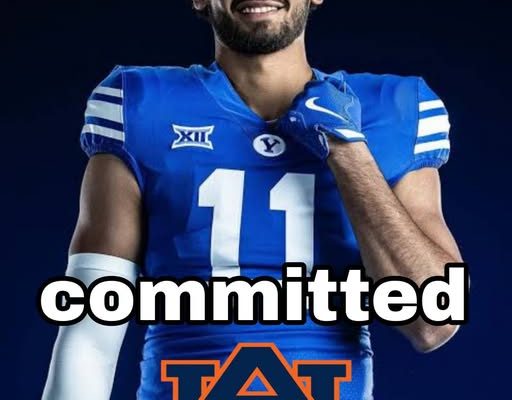The world of college football recruiting is always buzzing with excitement, anticipation, and sometimes surprise when the top prospects make their decisions about where they will take their talents at the next level. Recently, one of the most highly anticipated commitments in the 2025 recruiting class shook up the Southeastern Conference and the entire college football landscape when the No. 1-ranked American football recruit announced his decision to commit to the Auburn Tigers. This choice came over two other powerhouse programs that were heavily pursuing him: the Tennessee Volunteers and the Florida Gators. This article explores the significance of this commitment, what it means for Auburn, and how it impacts Tennessee, Florida, and the broader college football recruiting scene.
The recruit in question, widely regarded as the No. 1 player in the nation for his class, had his recruitment tracked extensively by fans, analysts, and media outlets alike. Coming out of a highly competitive high school program, this athlete showcased rare combination of speed, agility, power, and football IQ, qualities that have led many experts to predict a stellar collegiate career and potential future stardom in the NFL. His skill set is not only versatile but also adaptable, able to contribute on offense, defense, or special teams depending on the scheme and coaching staff’s vision.
For Auburn, landing this recruit is a huge coup. The Tigers have been actively working to elevate their program and return to national prominence. Historically a powerhouse in the SEC, Auburn has faced stiff competition in recent years, especially from their in-state rival Alabama and other SEC heavyweights like Georgia and LSU. However, the recruitment and commitment of the nation’s top player signal a renewed commitment to building a team capable of competing at the highest level. It serves as a strong message to other recruits, current players, and fans that Auburn is a destination for elite talent.
When considering the decision from the recruit’s perspective, multiple factors likely influenced his choice. Auburn’s coaching staff is known for its ability to develop players and prepare them for professional success, with several recent alumni making it to the NFL and thriving at the next level. Additionally, Auburn’s facilities, academic support, and campus environment may have contributed to the appeal. The coaching staff’s vision for how they would utilize his talents likely resonated with the recruit and his family, giving them confidence in the program’s direction and culture.
Another important factor in this commitment is the fierce competition Auburn faced from Tennessee and Florida. Both programs have deep recruiting histories and remain highly competitive in the SEC East and overall college football rankings. Tennessee, led by a coaching staff with a strong regional recruiting footprint, had been making significant strides in building its program and returning to relevance on the national stage. Florida, historically one of the most dominant programs in the SEC, continues to attract top-tier talent and boasts a long legacy of producing NFL players. The fact that Auburn was able to sway this top recruit away from these two rivals highlights the program’s growing momentum and ability to compete at the highest level in recruiting battles.
This recruitment also reflects larger trends in college football recruiting, particularly in the SEC, which has long been the premier conference in the sport. The conference’s dominance in terms of national championships and NFL draft picks is well documented, and the battle for elite recruits within the SEC is among the fiercest in the country. Each major program within the conference is continuously striving to out-recruit and out-develop the others, understanding that talent acquisition is a key component in achieving on-field success. Auburn’s success in landing the No. 1 recruit may shift recruiting dynamics in the region and inspire other top prospects to consider the Tigers more seriously.
For Tennessee and Florida, losing out on the nation’s top recruit is a setback, but not a terminal one. Both programs still boast strong recruiting classes and have shown the ability to develop high-level talent consistently. Their pursuit of the recruit likely provided valuable information and experience that can be leveraged in future recruiting efforts. Additionally, the competitive nature of recruiting means that no program ever secures every top player, and there will always be opportunities to sign other impactful athletes who fit their systems and culture.
Looking ahead, Auburn’s challenge will be to integrate this elite recruit into their system and maximize his potential. Recruiting is only the first step; the real test lies in how well the program develops the athlete on and off the field. Auburn’s coaches will need to work closely with the recruit to ensure a smooth transition to college football, both in terms of mastering the playbook and adjusting to the increased physical and mental demands of the sport at the collegiate level. The program will also focus on supporting the recruit academically and socially to ensure a well-rounded and successful college experience.
This commitment is also likely to have a ripple effect in future recruiting cycles. High-profile commitments from top-ranked players tend to attract other talented recruits who want to play alongside elite peers and compete for championships. Auburn’s ability to sign the No. 1 recruit could serve as a catalyst to build momentum, attracting other prospects who want to be part of the Tigers’ resurgence. It sends a clear message that Auburn is serious about competing for SEC titles and national championships, which is a critical selling point for top-tier athletes.
Moreover, this recruiting victory may energize Auburn’s fanbase and alumni network, leading to increased support for the program in terms of attendance, donations, and overall enthusiasm. Successful recruiting often translates into greater excitement around the team and can have positive effects on the program’s financial health and public image. Auburn’s leadership will likely leverage this commitment in marketing and promotional efforts to build hype and maintain the momentum going forward.
It is worth noting that the landscape of college football recruiting has evolved significantly in recent years due to changes such as the transfer portal, name-image-likeness (NIL) deals, and the increased visibility of players through social media and televised high school games. These factors have added complexity to recruiting, requiring programs to be more strategic and proactive in engaging with prospects and their families. Auburn’s success in landing this recruit suggests the program is adapting well to these changes and is able to compete in the modern recruiting environment.



